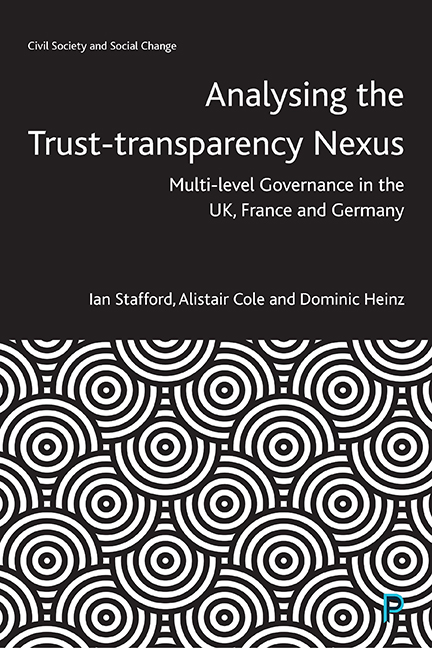Book contents
- Frontmatter
- Dedication
- Contents
- List of figures and tables
- List of abbreviations
- About the authors
- Acknowledgements
- Introduction
- 1 Building trust in an age of transparency
- 2 The trust–transparency nexus
- 3 Comparing cases
- 4 UK: North West England and Wales
- 5 Germany: Hesse and Saxony-Anhalt
- 6 France: Auvergne-Rhône-Alpes and Bretagne
- Conclusion: reflections on the trust–transparency nexus
- Appendix: qualitative fieldwork guide
- References
- Index
3 - Comparing cases
Published online by Cambridge University Press: 15 September 2022
- Frontmatter
- Dedication
- Contents
- List of figures and tables
- List of abbreviations
- About the authors
- Acknowledgements
- Introduction
- 1 Building trust in an age of transparency
- 2 The trust–transparency nexus
- 3 Comparing cases
- 4 UK: North West England and Wales
- 5 Germany: Hesse and Saxony-Anhalt
- 6 France: Auvergne-Rhône-Alpes and Bretagne
- Conclusion: reflections on the trust–transparency nexus
- Appendix: qualitative fieldwork guide
- References
- Index
Summary
The research project that provides the source for this book is first and foremost a comparative one. According to Swanson (1971: 145), ‘thinking without comparison is unthinkable. And, in the absence of comparison, so is all scientific thought and scientific research’. Ragin (1987: 6) contends that comparison allows identification of the similarities and differences between political phenomena. Furthermore, ‘this knowledge provides the key to understanding, explaining, and interpreting diverse historical outcomes and processes and their significance for current institutional arrangements’. The next three chapters exploring our cases are designed to fulfil the aims identified by Ragin, and the final chapter brings together our findings. This chapter provides the foundations for this comparative analysis. The first section will position the approach adopted in the second half of the book within the context of comparative social research. The second section will begin to introduce our three cases, providing an overview of their wider context. The final section features introductions to the multi-level government contexts within each of the three country cases and specifically the six territorial cases that are the primary focus of our research.
Our comparative approach
The debates around the strengths and weaknesses of the variety of types and forms of comparative analysis are well rehearsed in the academic literature. Peters (2013: 6), for example, argues that despite contrasting approaches to comparative politics that can be found within the academic literature, they all ‘confront a fundamental trade-off between the respective virtues of complexity and generalization’. On the one hand, the single case study enables the exploration of the context and complexities of a single political system but provides limited scope for generalisation. On the other hand, a statistical modelling approach to comparison facilitates robust generalisation, but provides less nuance around the specific political systems encompassed in the study. Ragin (1987) characterises two primary methodological orientations: variables-based and case-based strategies. The former tends to characterise quantitative research, investigating many cases – or adopting a large-N approach – with few variables. In contrast, the latter is associated with qualitative research, focusing on a limited number of cases but witha large number of variables. Peters (2013: 6) notes that these types of approaches tend to be characterised by ‘thick description’ that involves a sophisticated ‘understanding of the social, cultural and economic context of politics’.
- Type
- Chapter
- Information
- Analysing the Trust-Transparency NexusMulti-level Governance in the UK, France and Germany, pp. 43 - 60Publisher: Bristol University PressPrint publication year: 2022

